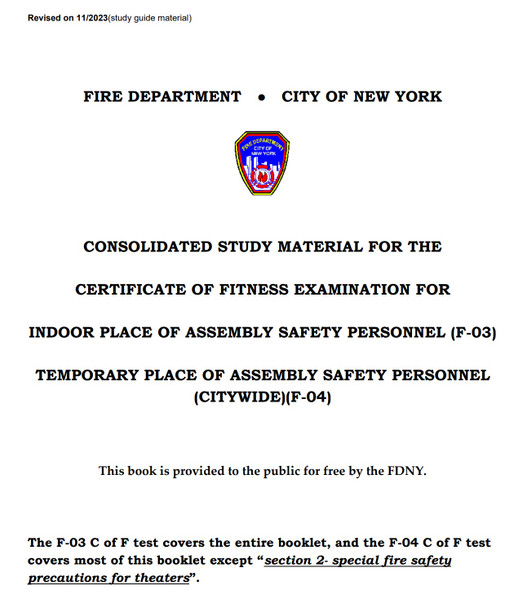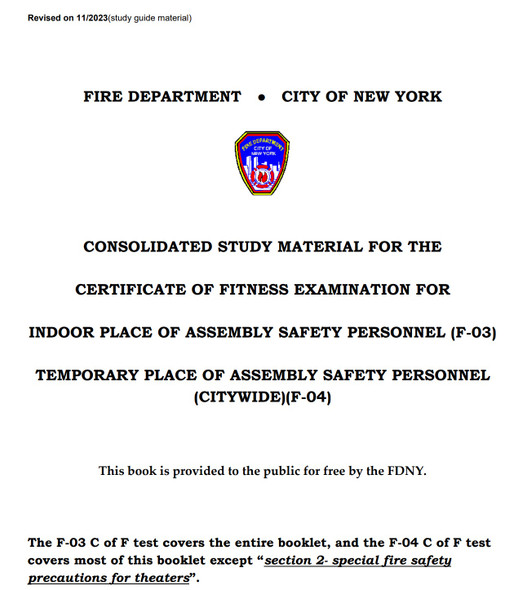- Home
- ** FREE DOWNLOADS FDNY **
- FDNY STUDAY MATERIAL FOR CERTIFICATE OF FITNESS FOR STANDPIPE (pdf file MARCH 2024)
hpdsigns.nyc
FDNY STUDAY MATERIAL FOR CERTIFICATE OF FITNESS FOR STANDPIPE (pdf file MARCH 2024)
- SKU:
- FDNY STUDAY MATERIAL FOR CERTIFICATE OF FITNESS FOR STANDPIPE
- UPC:
- MPN:
- FDNY STUDAY MATERIAL FOR CERTIFICATE OF FIT
Description
FDNY STUDAY MATERIAL FOR CERTIFICATE OF FITNESS FOR STANDPIPE - PDF FORMAT
Study Material for the Examination for the Certificate of Fitness for Standpipe System
Introduction
A Standpipe System is an integral component of fire protection in buildings, especially in high-rise structures commonly found in New York City (NYC). This system provides a reliable water supply to firefighting personnel during emergencies. As such, the proper installation, maintenance, and operation of these systems are critical for safety. Obtaining a Certificate of Fitness (COF) for Standpipe Systems is a legal requirement for individuals responsible for overseeing these systems in NYC. This article provides a comprehensive guide to the study material for the COF examination and highlights the importance of holding this certification.
Study Material for the COF Examination
1. Understanding Standpipe Systems
Types of Standpipe Systems
- Class I: Designed for use by firefighters. These systems include 2½-inch hose connections.
- Class II: Equipped with 1½-inch hose connections for use by building occupants until the fire department arrives.
- Class III: A combination of Classes I and II, featuring both 1½-inch and 2½-inch hose connections.
Components of Standpipe Systems
- Water Supply: Sources such as gravity tanks, pressure tanks, or direct connections to municipal water systems.
- Piping: Includes risers, cross mains, and branch lines.
- Valves: Control water flow, including isolation valves, check valves, and pressure-reducing valves.
- Fire Department Connections (FDCs): Allows firefighters to pump additional water into the standpipe system.
- Hose Stations: Equipped with hoses and nozzles for use in firefighting.
2. Firefighting Techniques and Safety
- Fire Behavior: Understanding the combustion process, fire growth, and spread.
- Fire Suppression Methods: Techniques for using water effectively to extinguish fires.
- Safety Procedures: Personal protective equipment (PPE), evacuation protocols, and emergency communication.
3. NYC Fire Code and NFPA Standards
- NYC Fire Code: Local laws and regulations governing fire safety in NYC, including specific requirements for standpipe systems.
- NFPA 14: Standard for the installation of standpipe and hose systems.
- NFPA 25: Standard for the inspection, testing, and maintenance of water-based fire protection systems.
4. Inspection, Testing, and Maintenance
- Routine Inspections: Daily, weekly, monthly, and annual checks to ensure system readiness.
- Testing Procedures: Methods for testing water flow, pressure, and alarm functionality.
- Maintenance Practices: Keeping the system in good working order, addressing leaks, corrosion, and other issues.
5. Emergency Response and Procedures
- Incident Command System (ICS): Structure for managing emergency response.
- Communication Protocols: Effective communication with fire departments and building occupants during emergencies.
- Evacuation Plans: Ensuring safe evacuation routes and procedures are in place.
Importance of Having the Certificate in NYC
1. Legal Compliance
In NYC, it is a legal requirement for individuals responsible for standpipe systems to hold a COF. The NYC Fire Department (FDNY) enforces these regulations to ensure that all personnel are adequately trained and knowledgeable about fire protection systems. Failure to comply can result in fines, legal action, and increased liability in the event of a fire.
2. Ensuring Safety
Properly maintained and operated standpipe systems are crucial for the safety of building occupants and firefighters. Holding a COF ensures that individuals have the necessary expertise to manage these systems effectively, reducing the risk of system failure during emergencies.
3. Professional Credibility
Obtaining a COF demonstrates a high level of professionalism and competence in fire safety management. It enhances the credibility of individuals and companies responsible for building maintenance and fire protection, leading to better job opportunities and career advancement.
4. Enhanced Emergency Preparedness
With a COF, individuals are better prepared to handle fire emergencies. They possess the skills to conduct regular inspections, perform necessary maintenance, and respond swiftly and effectively during a fire, thereby minimizing damage and potential loss of life.
5. Community Trust
Residents and occupants of buildings with standpipe systems place their trust in the individuals responsible for fire safety. Holding a COF reassures the community that their safety is in capable hands, fostering a sense of security and confidence.
Conclusion
The Certificate of Fitness for Standpipe Systems is a vital credential for anyone involved in the management and operation of these critical fire protection systems in New York City. By understanding the study material and recognizing the importance of this certification, individuals can contribute to a safer and more secure urban environment. Whether you are preparing for the COF examination or ensuring compliance with local fire codes, the knowledge and skills gained from this certification are invaluable.
DISCLAIMER these codes may not be the most recent version. The State / federal or other regulation department may have more current or accurate information. We make no warranties or guarantees about the accuracy, completeness, or adequacy of the information contained on this site or the information linked to on the state site. Please check official sources. The requirements for detector are determined by intended use and by applicable regulation. The BUYER is responsible for determining the appropriate detector needed.
WE make no warranty or representation of suitability of a detector to any code or for any specific application. IT IS THE CUSTOMER'S RESPONSIBILITY TO ENSURE THAT THE DETECTORS THE CUSTOMER ORDERS ARE IN COMPLIANCE WITH ALL STATE, FEDERAL, LOCAL, AND MUNICIPAL LAWS. Please review terms and conditions prior to purchase. For more information about what is required, see the laws that are referenced and the rules applicable to your city and state. This page is for informational purposes only and is not intended as legal advice, professional advice or a statement of law. You may wish to consult with an attorney.
Related Products


CONSOLIDATED STUDY MATERIAL FDNY 2023 (PDF FILE)
hpdsigns.nyc

2023-2024 Fire and Emergency Preparedness Bulletin for Apt Building-FDNY (pdf file)
hpdsigns.nyc


FDNY'S TOP SEVEN FIRE SAFETY RULES FLYER (pdf file)
hpdsigns.nyc

Natural Gas Safety and the Importance of Leak Detectors: Guidance from FDNY (pdf file)
hpdsigns.nyc

Safe Lithium-Ion Battery Charging and Storage Based on FDNY Guidelines (pdf file)
hpdsigns.nyc


fdny smart have an escape plan (PDF)
hpdsigns.nyc

Abc's of housing tenant's guide 2024 (PDF FILE)
hpdsigns.nyc




